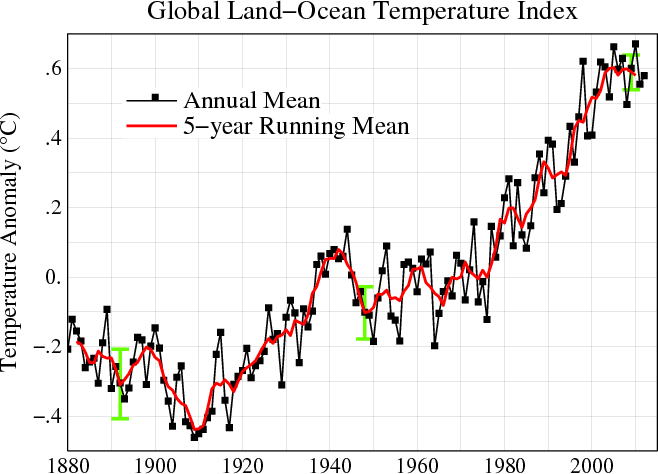
Impacts of Climate Change on River Systems
Climate Change
It has been proven and accepted by the scientific community that the Earth is getting warmer. The best representation of this fact comes from the NASA GISS data sets and graphs. NASA GISS uses satellites to observe temperatures across the planet, which are then converted into graphs and maps showing the warming trends.
Some may argue that this is a natural process and that the Earth has seen much warmer periods in its past. And while temperature variation is indeed a natural process and there have been warmer periods in Earth's history; this time we are the cause to the rapid increase in temperature. Today the increased emissions of greenhouse gasses are attributed to this warming trend. Greenhouse gasses include: carbon dioxide, methane, nitrous oxide, and water vapor (EPA, 2013). Of all the greenhouse gases carbon dioxide is the most common and since 1990 the global emissions have risen from 23,000 to well over 30,000 teragrams of carbon dioxide per year (EPA, 2013).
Earth receives energy from the sun in the form of short wave radiation. Some of this energy is reflected back into space but most of it is absorbed by the surfaces it reaches. Once absorbed there are several directions in which the energy can be transfer but most of it is released as long wave radiation. When this long wave radiation encounters greenhouse gas molecules in the atmosphere it is bounced back the Earth's surface, retaining the heat. This is what make cloudy nights warmer than clear ones. As we burn more fossil fuels, the concentrations of greenhouse gases in the atmosphere increase. With more greenhouse gas molecules in the air, the more likely it is for the long wave radiation to be bounced back down and the warmer the planet becomes (Lindsey, 2009).

Impacts Climate Change
Now that the warming of the Earth has been established, what does it mean? For most of us it means we might have to turn up the air conditioning during the summer or water the lawn more frequently. It is only a few degrees after all. However, there are a variety of impacts that do in fact affect us. These include melting glaciers and ice caps, rising sea level, increased evaporation, altered weather patterns, and increased natural disasters, like floods. All of these have a direct impact on our society and at least an indirect impact on us individually. Of these impacts, the trend among them is the involvement of water and its distribution.

The above map of the world displays the temperature changes seen from 1990 to 2010 recorded from NASA GISS. And while not all regions show a warming trend the average trend is still one of increasing temperatures. Below is a graph depicting the temperature changes that the planet has seen since seen 1880. In this graph, it is very clear to see that since 1880 the average global temperature has increased 0.8 degrees Celsius. While this is a very small increment to us, this can mean the difference between life and death for many organisms.
References
EPA. (2013, September 9). Climate Change. Retrieved December 13, 2013, from Global Greenhouse Gas Emissions Data: http://www.epa.gov/climatechange/ghgemissions/global.html
EPA. (2013, September 13). Climate Change Indicators in the United States. Retrieved December 13, 2013, from Greenhouse Gases: http://www.epa.gov/climatechange/science/indicators/ghg/
Lindsey, R. (2009, January 14). NASA Earth Observatory. Retrieved December 13, 2013, from Climate and Earth's Energy Budget: http://earthobservatory.nasa.gov/Features/EnergyBalance/page1.php
NSA GISS. (2013, December 10). National Aeronautics and Space Administration Goddard Institute for Space Studies. Retrieved December 2013, 2013, from NASA Goddard Institute for Space Studies: http://www.giss.nasa.gov/
